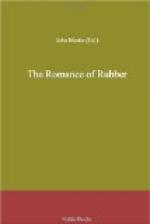In the next century after Columbus’s travels the Portuguese founded the colony of Brazil on the continent of South America. Their settlements were near the coast and they did not begin to explore the great Amazon region for a hundred years or so. The journey down this great river—which Theodore Roosevelt took so many years later—was first made by a Portuguese missionary, who found the same kind of gummy tree juice as that of the West Indies. But the natives along the Amazon had discovered that besides being elastic it was waterproof, and they were making shoes that would keep out water. You can picture a native boy spilling some of this liquid on his foot, then covering it, as he might with a mud pie, and when it dried wiggling his toes to find that, he had the first and perhaps the best fitting gum shoe that ever was made.
Little by little samples of this new substance found their way to Europe. It was another hundred years before thoughtful men believed it worth while to investigate this gum. In 1731 the Paris Academy of Science sent some explorers to learn about it. One of these Frenchmen, La Condamine, wrote of a tree called “Hevea” [Footnote: Hevea is pronounced Hee’-vee-uh. Caoutchouc is pronounced koo’-chook.] “There flows from this tree a liquor which hardens gradually and blackens in the air.” He found the people of Quito waterproofing cloth with it, and the Amazon Indians were making boots which, when blackened in smoke, looked like leather. Most interesting of all, they coated bottle-shaped moulds, and when the gum had hardened they would break the mould, shaking the pieces out of the neck, leaving an unbreakable bottle that would hold liquids.
It was not long afterwards that Lisbon began to import some of these crudely fashioned articles, and it is said that in 1755 the King of Portugal sent to Brazil several pairs of his boots to be waterproofed. A few years later the Government of Para, Brazil, sent him a full suit of rubber clothes. For all that, this elastic gum was for the most part only a curiosity, and few people knew there was such a thing.
About the year 1770, a black, bouncing ball of caoutchouc, as the Indians called the gum, after many travels found its way to England, and Priestley, the man who gave us oxygen, learned that it would rub out pencil marks. Then and there he named it what you have probably guessed long before this: “rub-ber.” Nearly every language except English uses in place of the word rubber some form of the native Word “caoutchouc,” which means “weeping tree.” After Priestley’s discovery, a one-inch “rubber” sold for three shillings, or about seventy-five cents, but artists were glad to pay even that price, because their work was made so much easier.
CHAPTER 2
CHARLES GOODYEAR
In 1800 Brazil was the only country manufacturing rubber articles, and her best market soon proved to be North America. Probably the first rubber this country saw was brought to New England in clipper ships as ballast in the form of crude lumps and balls. Rubber shoes, water-bottles, powder-flasks, and tobacco-pouches found buyers in the American ports, but rubber shoes were most in demand.




